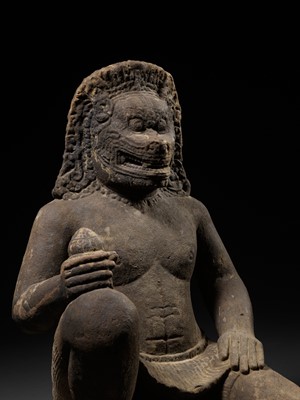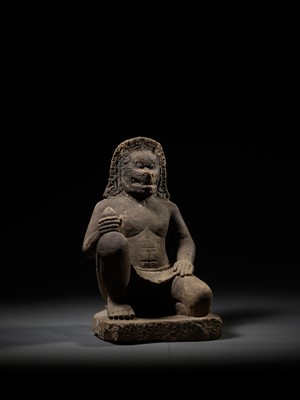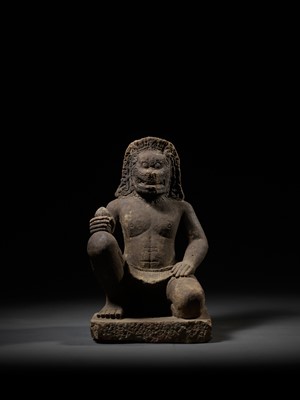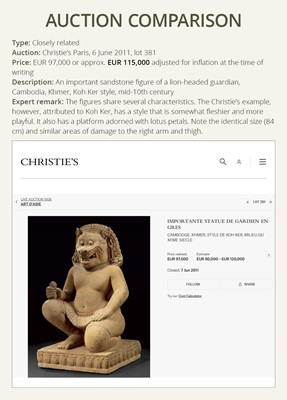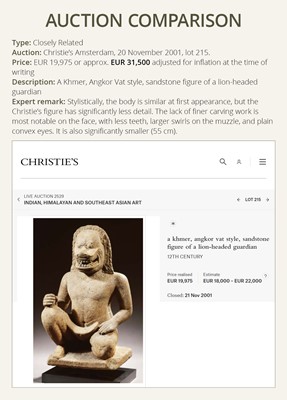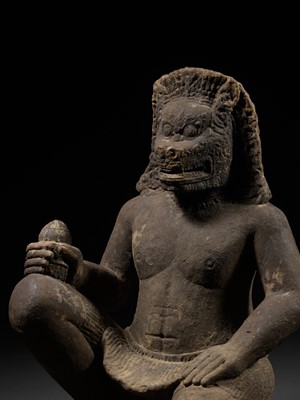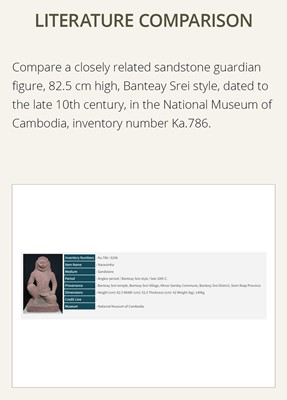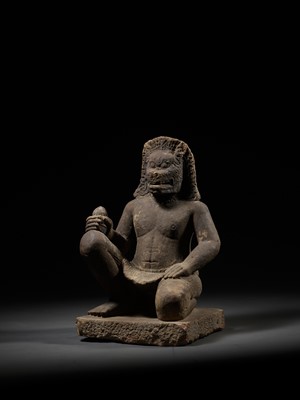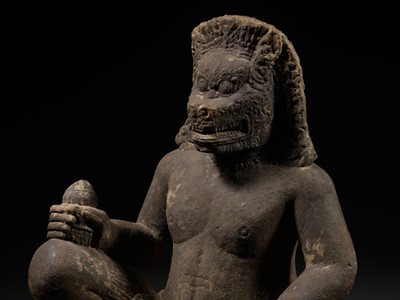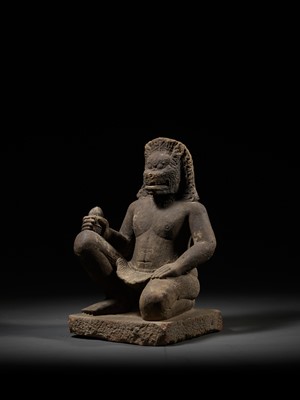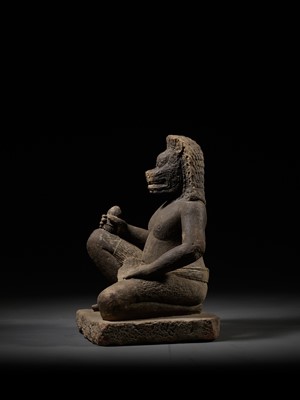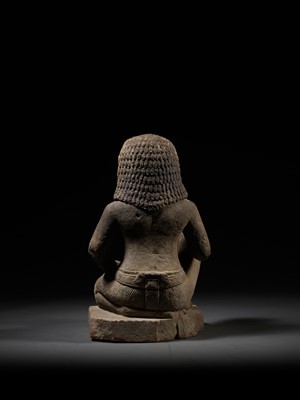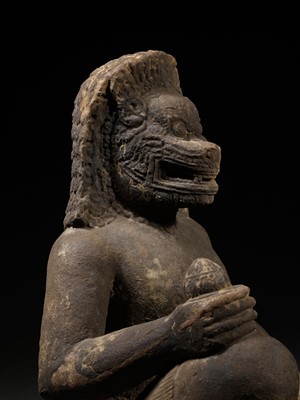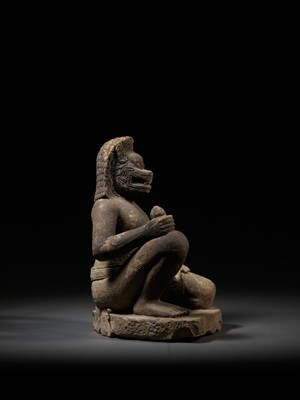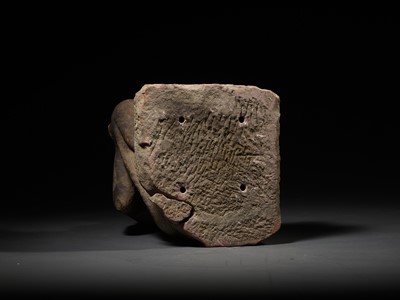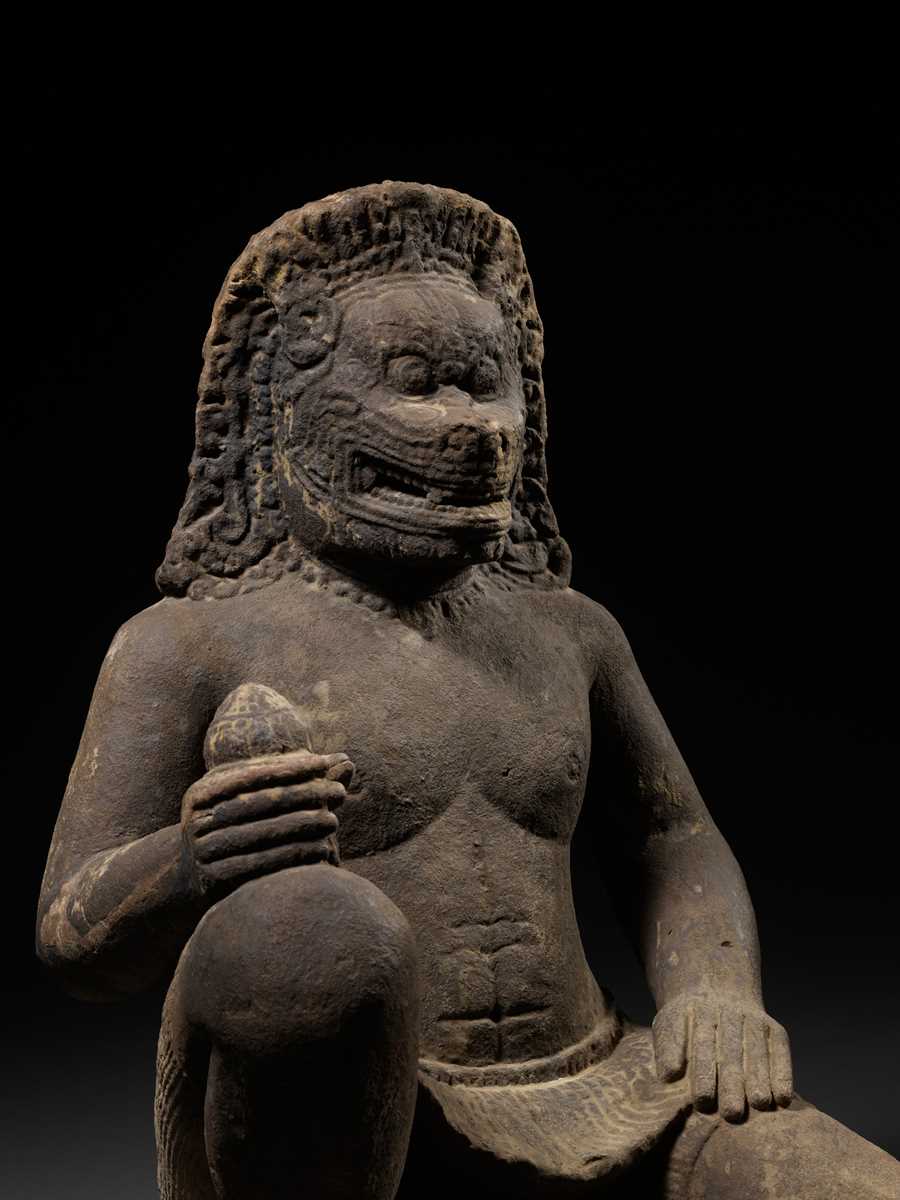9th Mar, 2023 13:00
TWO-DAY AUCTION - Fine Chinese Art / 中國藝術集珍 / Buddhism & Hinduism
219
A MONUMENTAL SANDSTONE FIGURE OF NARASIMHA, KHMER EMPIRE, 10TH-12TH CENTURY
Sold for €14,300
including Buyer's Premium
Finely carved to depict an imposing anthropomorphic guardian with a fierce gaze, displaying the head of a lion and body of a man, kneeling on a square plinth, wearing a pleated sampot, holding a vajra in his right hand. Note the unusually elaborate coiffure, especially at the backside of the head.
Provenance: An old collection in the United States, formed between the 1970s and 1990s, by repute acquired as part of a deaccession from an American museum. A private collection in California, United States, acquired from the above.
Condition: Overall good condition, commensurate with age. Extensive wear, some losses, dents, structural cracks with associated old fills, signs of weathering and erosion, drilled to underside of platform. Fine, naturally grown patina.
Dimensions: Height 84 cm
Such imposing figures, a symbol of both caution and importance, once served as guardians at the gates and entrances of sacred temple sites throughout Southeast Asia. The mythical composition of the figure, in addition to the presence of a celestial weapon, alludes to this being a divine being with powers far greater than that of any mortal. The iconography, an evolutionary mix of lion imagery with fierce deities, is one repeated throughout the ancient world, from the Gates of Ishtar to the Temple of Todaiji.
Expert’s note: The figure compares well against closely related examples that have come on the market in the last century, however also exhibits subtle stylistic differences from each that make connecting it to any specific temple site or region difficult. This is further confounded by the fact that many known sites are in varied states of disarray and near complete ruin. For example, if compared with the Banteay Srei guardians, we see that the vajra is proportionally much larger, and the style of the face is much more rectangular. The two are clearly from different areas. In addition to the old restorations, the figure exhibits other attractive signs of weathering, including complex organic growth in the form of black algae (upper torso) and crustose lichens (left knee), and is decidedly ancient. We must conclude that the figure is from a yet unknown site somewhere else in the vast ancient Khmer empire, an empire that at its peak was larger than the Byzantine Empire.
Literature comparison:
Compare a closely related sandstone figure of Narasimha, 82.5 cm high, Banteay Srei style, dated to the late 10th century, in the CB National Museum, inventory number Ka.786. Note the difference in gaze, being downward facing versus straight-on, the noticeably smaller vajra, and the thicker platform. Interestingly, note the very similar damage to the right arm and right thigh, damage that is also shared to some extent with a comparison from Christie’s below. The figure in the CB National Museum appears to exhibit fewer characteristic signs of surface weathering than the present lot and in comparison has the feeling of being a younger figure.
Auction result comparison:
Type: Closely related
Auction: Christie’s Paris, 6 June 2011, lot 381
Price: EUR 97,000 or approx. EUR 115,000 adjusted for inflation at the time of writing
Description: An important sandstone figure of a lion-headed guardian, Khmer, Koh Ker style, mid-10th century
Expert remark: The figures share several characteristics. The Christie’s example, however, attributed to Koh Ker, has a style that is somewhat fleshier and more playful. It also has a platform adorned with lotus petals. Note the identical size (84 cm) and similar areas of damage to the right arm and thigh.
Auction result comparison:
Type: Closely Related
Auction: Christie’s Amsterdam, 20 November 2001, lot 215.
Price: EUR 19,975 or approx. EUR 31,500 adjusted for inflation at the time of writing
Description: A Khmer, Angkor Vat style, sandstone figure of a lion-headed guardian
Expert remark: Stylistically, the body is similar at first appearance, but the Christie’s figure has significantly less detail. The lack of finer carving work is most notable on the face, with less teeth, larger swirls on the muzzle, and plain convex eyes. It is also significantly smaller (55 cm).
Finely carved to depict an imposing anthropomorphic guardian with a fierce gaze, displaying the head of a lion and body of a man, kneeling on a square plinth, wearing a pleated sampot, holding a vajra in his right hand. Note the unusually elaborate coiffure, especially at the backside of the head.
Provenance: An old collection in the United States, formed between the 1970s and 1990s, by repute acquired as part of a deaccession from an American museum. A private collection in California, United States, acquired from the above.
Condition: Overall good condition, commensurate with age. Extensive wear, some losses, dents, structural cracks with associated old fills, signs of weathering and erosion, drilled to underside of platform. Fine, naturally grown patina.
Dimensions: Height 84 cm
Such imposing figures, a symbol of both caution and importance, once served as guardians at the gates and entrances of sacred temple sites throughout Southeast Asia. The mythical composition of the figure, in addition to the presence of a celestial weapon, alludes to this being a divine being with powers far greater than that of any mortal. The iconography, an evolutionary mix of lion imagery with fierce deities, is one repeated throughout the ancient world, from the Gates of Ishtar to the Temple of Todaiji.
Expert’s note: The figure compares well against closely related examples that have come on the market in the last century, however also exhibits subtle stylistic differences from each that make connecting it to any specific temple site or region difficult. This is further confounded by the fact that many known sites are in varied states of disarray and near complete ruin. For example, if compared with the Banteay Srei guardians, we see that the vajra is proportionally much larger, and the style of the face is much more rectangular. The two are clearly from different areas. In addition to the old restorations, the figure exhibits other attractive signs of weathering, including complex organic growth in the form of black algae (upper torso) and crustose lichens (left knee), and is decidedly ancient. We must conclude that the figure is from a yet unknown site somewhere else in the vast ancient Khmer empire, an empire that at its peak was larger than the Byzantine Empire.
Literature comparison:
Compare a closely related sandstone figure of Narasimha, 82.5 cm high, Banteay Srei style, dated to the late 10th century, in the CB National Museum, inventory number Ka.786. Note the difference in gaze, being downward facing versus straight-on, the noticeably smaller vajra, and the thicker platform. Interestingly, note the very similar damage to the right arm and right thigh, damage that is also shared to some extent with a comparison from Christie’s below. The figure in the CB National Museum appears to exhibit fewer characteristic signs of surface weathering than the present lot and in comparison has the feeling of being a younger figure.
Auction result comparison:
Type: Closely related
Auction: Christie’s Paris, 6 June 2011, lot 381
Price: EUR 97,000 or approx. EUR 115,000 adjusted for inflation at the time of writing
Description: An important sandstone figure of a lion-headed guardian, Khmer, Koh Ker style, mid-10th century
Expert remark: The figures share several characteristics. The Christie’s example, however, attributed to Koh Ker, has a style that is somewhat fleshier and more playful. It also has a platform adorned with lotus petals. Note the identical size (84 cm) and similar areas of damage to the right arm and thigh.
Auction result comparison:
Type: Closely Related
Auction: Christie’s Amsterdam, 20 November 2001, lot 215.
Price: EUR 19,975 or approx. EUR 31,500 adjusted for inflation at the time of writing
Description: A Khmer, Angkor Vat style, sandstone figure of a lion-headed guardian
Expert remark: Stylistically, the body is similar at first appearance, but the Christie’s figure has significantly less detail. The lack of finer carving work is most notable on the face, with less teeth, larger swirls on the muzzle, and plain convex eyes. It is also significantly smaller (55 cm).
Zacke Live Online Bidding
Our online bidding platform makes it easier than ever to bid in our auctions! When you bid through our website, you can take advantage of our premium buyer's terms without incurring any additional online bidding surcharges.
To bid live online, you'll need to create an online account. Once your account is created and your identity is verified, you can register to bid in an auction up to 12 hours before the auction begins.
Intended Spend and Bid Limits
When you register to bid in an online auction, you will need to share your intended maximum spending budget for the auction. We will then review your intended spend and set a bid limit for you. Once you have pre-registered for a live online auction, you can see your intended spend and bid limit by going to 'Account Settings' and clicking on 'Live Bidding Registrations'.
Your bid limit will be the maximum amount you can bid during the auction. Your bid limit is for the hammer price and is not affected by the buyer’s premium and VAT. For example, if you have a bid limit of €1,000 and place two winning bids for €300 and €200, then you will only be able to bid €500 for the rest of the auction. If you try to place a bid that is higher than €500, you will not be able to do so.
Online Absentee and Telephone Bids
You can now leave absentee and telephone bids on our website!
Absentee Bidding
Once you've created an account and your identity is verified, you can leave your absentee bid directly on the lot page. We will contact you when your bids have been confirmed.
Telephone Bidding
Once you've created an account and your identity is verified, you can leave telephone bids online. We will contact you when your bids have been confirmed.
Classic Absentee and Telephone Bidding Form
You can still submit absentee and telephone bids by email or fax if you prefer. Simply fill out the Absentee Bidding/Telephone bidding form and return it to us by email at office@zacke.at or by fax at +43 (1) 532 04 52 20. You can download the PDF from our Upcoming Auctions page.
How-To Guides
How to Create Your Personal Zacke Account
How to Register to Bid on Zacke Live
How to Leave Absentee Bids Online
How to Leave Telephone Bids Online
中文版本的操作指南
创建新账号
注册Zacke Live在线直播竞拍(免平台费)
缺席投标和电话投标
Third-Party Bidding
We partner with best-in-class third-party partners to make it easy for you to bid online in the channel of your choice. Please note that if you bid with one of our third-party online partners, then there will be a live bidding surcharge on top of your final purchase price. You can find all of our fees here. Here's a full list of our third-party partners:
- 51 Bid Live
- EpaiLive
- ArtFoxLive
- Invaluable
- LiveAuctioneers
- the-saleroom
- lot-tissimo
- Drouot
Please note that we place different auctions on different platforms. For example, in general, we only place Chinese art auctions on 51 Bid Live.
Bidding in Person
You must register to bid in person and will be assigned a paddle at the auction. Please contact us at office@zacke.at or +43 (1) 532 04 52 for the latest local health and safety guidelines.
